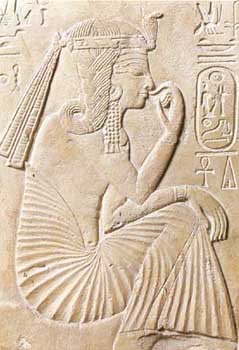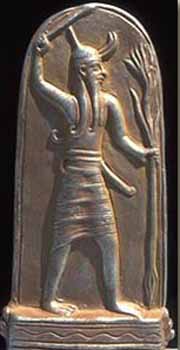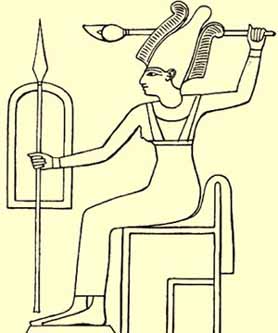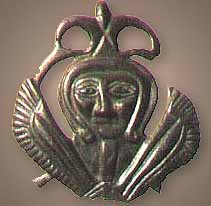

Anat first appears in Egypt in the 16th dynasty (the Hyksos period) along with other northwest Semitic deities. She was especially worshipped in her aspect of a war goddess, often paired with the goddess `Ashtart. In the Contest Between Horus and Set, these two goddesses appear as daughters of Re and are given in marriage to the god Set, who had been identified with the Semitic god Hadad.
During the Hyksos period Anat had temples in the Hyksos capital of Avaris and in Beth-Shan (Palestine) as well as being worshipped in Memphis. On inscriptions from Memphis of 15th to 12th centuries BCE, Anat is called "Bin-Ptah", Daughter of Ptah. She is associated with Reshpu, (Canaanite: Resheph) in some texts and sometimes identified with the native Egyptian goddess Neith. She is sometimes called "Queen of Heaven". Her iconography varies, but she is usually shown carrying one or more weapons.
The name of Anat-her, a shadowy Egyptian ruler of this time, is evidently derived from "Anat".
In the New Kingdom Ramesses II made �Anat his personal guardian in battle and enlarged Anat's temple in Pi-Ramesses. Ramesses named his daughter (whom he later married) Bint-Anat 'Daughter of Anat'. His dog appears in a carving in Beit el Wali temple with the name "Anat-in-vigor" and one of his horses was named �Ana-herte 'Anat-is-satisfied'.
In the Ugaritic Ba'al/Hadad cycle Anat is a violent war-goddess, a virgin in Ugarit though the sister and lover of the great Ba'al known as Hadad elsewhere. Ba'al is usually called the son of Dagon and sometimes the son of El. �Anat is addressed by El as "daughter". Either one relationship or the other is probably figurative. Anat's titles used again and again are "virgin Anat" and "sister-in-law of the peoples" (or "progenitress of the peoples" or "sister-in-law, widow of the Li'mites").
In a fragmentary passage from Ras Shamra Anat appears as a wild and furious warrior in a battle, wading knee-deep in blood, striking off heads, cutting off hands, binding the heads to her torso and the hands in her sash, driving out the old men and townsfolk with her arrows, her heart filled with joy. "Her character in this passage anticipates her subsequent warlike role against the enemies of Baal".
Anat boasts that she has put an end to Yamm the darling of El, to the seven-headed serpent, to Arsh the darling of the gods, to Atik 'Quarrelsome' the calf of El, to Ishat 'Fire' the bitch of the gods, and to Zabib 'flame?' the daughter of El. Later, when Ba�al is believed to be dead, she seeks after Ba'al "like a cow for its calf" and finds his body (or supposed body) and buries it with great sacrifices and weeping. Anat then finds Mot, Ba'al/Hadad's supposed slayer and she seizes Mot, splits him with a sword, winnows him with a sieve, burns him with fire, grinds him with millstones and scatters the remnants to the birds.
Text CTA 10 tells how 'Anat seeks after Ba'al who is out hunting, finds him, and is told she will bear a steer to him. Following the birth she brings the new calf to Ba'al on Mount Zephon. But nowhere in these texts is Anat explicitly Ba'al/Hadad's consort. To judge from later traditions' Athtart (who also appears in these texts) is more likely to be Ba'al/Hadad's consort. But of course northwest Semitic culture permitted more than one wife and liaisons outside marriage are normal for deities in all pantheons.
In the North Canaanite story of Aqhat, the protagonist Aqhat son of the judge Danel (Dn'il is given a wonderful bow and arrows which was created for Anat by the craftsman god Kothar-wa-Khasis but which was given to Dan[i]el for his infant son as a gift. When Aqhat grew to be a young man, the goddess Anat tried to buy the bow from Aqhat, offering even immortality, but Aqhat refused all offers, calling her a liar since old age and death are the lot of all men. He then added to this insult by asking what would a woman do with a bow?
Like Inanna in the Epic of Gilgamesh, Anat complained to El and threatened El himself if he did not allow her to take vengeance on Aqhat. El conceded. Anat launched her attendant Yatpan in hawk form against Aqhat to knock the breath out of him and to steal the bow back. Her plan succeeds, but Aqhat is killed instead of merely beaten and robbed. In her rage against Yatpan, (text is missing here) Yatpan runs away and the bow and arrows fall into the sea. All is lost. Anat mourned for Aqhat and for the curse that this act would bring upon the land and for the loss of the bow.
The focus of the story then turns to Paghat, the wise younger sister of Aqhat. She sets off to avenge her brother's death and to restore the land which has been devastated by drought as a direct result of the murder. The story is unfortunately incomplete. It breaks at an extremely dramatic moment when Paghat discovers that the mercenary whom she has hired to help her avenge the death is, in fact, Yatpan, her brother's murderer. The parallels between the story of �Anat and her revenge on Mot for the killing of her brother are obvious. In the end, the seasonal myth is played out on the human level.
Gibson (1978) thinks Rahmay 'The Merciful', co-wife of El with Athirat, is also the goddess �Anat but he fails to take into account the primary source documents. Most Ugaritic scholars point out that the dual names of deities in Ugaritic poetry is an essential part of the verse-form and that two names for the same deity are traditionally mentioned in parallel lines. In the same way Athirat, is called Elath (meaning "The Goddess") in paired couplets. The poetic structure can also be seen in early Hebrew verse forms.
Much of the world's religion today originated in the regions bordering the Mediterranean Sea, including what is today Israel, together with its neighboring countries. In ancient times, these old states often imported and exported their gods as people migrated about, as these nations fought each other in wars, a fact that certainly had no small impact on our modern beliefs. Often, the attributes of the gods of one region were incorporated into the gods of another region. An example of this is the goddess, Anat, who was one of a number of deities imported into Egypt from the Syrian region.�
The name Anat occurs in several forms in Ugaritic, Hebrew, Akkadian, and Egyptian, and as in such cases, the forms may vary widely. For example, in the Ugarit V Deity List it is spelled da-na-tu to be pronounced 'Anatu'. Otherwise in Phoenician it is `nt and is pronounced 'Anat', 'Anatu', 'Anath' or 'Anata'. The name is usually translated from Hebrew as 'Anath', but it could also be 'Anat'. The Akkadian form is usually written as 'Anta' or 'Antu'. The Egyptian forms are 'Anant', 'Anit', 'Anti', and 'Antit'. We may also find variations of her name in reference books such as Anthat.
A major goddess of fertility, sexual love, hunting and war, the Goddess Anat was known among the Canaanites in prehistoric times, and was doubtless of considerable importance in that region.� From the fertile agricultural area along the eastern Mediterranean coast, her cult spread throughout the Levant by the middle of the third millennium BC. Around the beginning of the Phoenician period (circa 1200 BC) Anat enjoyed a significant cult following. She was very prominent at Ugarit, a major religious center, and appears frequently in Ugaritic literary works incorporating mythical elements, in deity and offering lists, and in votive inscriptions.
Her cult became established in Egypt by the end of the Middle Kingdom, even before the Hyksos (Asiatics probably from Syria) invasion of Egypt, so her presence certainly attests to the slow immigration (or perhaps more often, enslavement as the spoils of war) of the Hyksos prior to their ultimate rule of Egypt. However, she attained prominence, particularly in the north (the Delta) during the Second Intermediate Period rule of the Hyksos, who appear to have promoted her cult in Egypt. She was represented at Memphis like all but the most local of deities, and sanctuaries were dedicated to her at the Hyksos capital of Tanis (Egypt) and Beth-Shan (Palistine).�
Yet, while the rulers of Egypt's New Kingdom took every step to denounce the Hyksos dynasty, her prestige reached its height in Egypt under Ramesses II who adopted Anat as his personal guardian in battle. Even Ramesses II's dog, shown rushing onto a vanquished Libyan in a carving in Beit el Wali temple, has the name "Anat in vigor". He also named his daughter (whom he later married) Bint-Anat, which means Daughter of Anat. He rebuilt Tanis and enlarged the sanctuary of Anat there. The Elephantine papyri dating from the late sixth century BC indicate that Anat was one of the two goddesses worshiped at the Temple of Yahu (Yahweh) by the Jews on the island of Elephantine in the Nile.
In Lebanon, Syria, and Palestine the worship of Anat persisted into Christian times (c. 200 AD), and perhaps much longer in popular religion. In Egypt traditional religion was practiced until the end of the Egyptian period (c. 400 AD). Anat may have been worshiped in one or more of the few Egyptian temples that remained open into the early 6th century AD. In contemporary times the worship of Anat has been revived in neo-pagan religion.

In Ugaritic texts she is the daughter of El, sister (though perhaps not literally) and consort of Baal. As Ba`al's companion and help-mate, She is goddess of dew and the fertility that it brings. Apparently, through the union of Anat and Baal, an offspring was born in the form of a wild bull. She may be Rachmay, one of the two nursemaids of the Gracious Gods mentioned in the eponymous ritual text. She is also the twin sister of Myrrh. At Tanis in Egypt she was regarded as the daughter of Re. In the Egyptian myth of the Contest between Horus and Seth, Anat and Astarte appear as daughters of Re and consorts of Seth (whom the Egyptians themselves identified with Baal).
From cuneiform text, Anat appears much the ruthless goddess. In her martial aspect she confines herself to slaying the enemies of Baal. She participates in the confrontation between Baal and Yam-Nahar. In a missing portion of the text she slays Yam and other enemies of Baal. During a victory celebration she departs to slaughter the warriors of two local towns. She joyfully wades in their blood, pours a peace offering and cleans up. She intercedes with El on Baal's behalf to obtain the necessary permission for a palace to be built for Baal. Later, when Baal is killed by Mot (Death) in an archetypal battle, she buries him, hunts down Mot, and takes revenge by cutting, winnowing, grinding, and burning Mot like grain. In another myth she coveted the splendid bow belonging to a youth called Aqhat. When he refuses to part with this bow, Ana sends an eagle to slay him.

Although terrible as a war deity she was regarded as a just and benevolent goddess of beauty, sexuality, and of the fertility of crops, animals, and men. Her grace and beauty were considered among the acme of perfection.� Anat is a complex and somewhat paradoxical goddess as can be seen from the epithets applied to her. Although she is regarded as the mother of gods, the most common epithet at Ugarit is batulat, Virgin or Maiden. She is sometimes called Wanton, in reference to her putative lust for sexual intercourse and the bloodshed of war. Other common epithets include: Adolescent Anat, Fairest daughter-sister of Baal, Lady, Strength of Life, Anat the Destroyer, and Lady of the Mountain.
`Anat� was considered by the Egyptians to be similar to Neith/Net, an ancient goddess from the Nile delta, with whom they identified Her. Neith is a skilled weaver and guardian of domestic life, as well as a goddess of war, whose symbols include crossed arrows on an animal skin or shield and a weaver's shuttle. `Anat is interpreted as being depicted with a spindle as well as Her spear, and as the Canaanites/ Phoenicians were famed for their weaving, She may well have been a patroness of that skill, perhaps also of the famed dye, later known as Tyrian purple, which could also be a blood red color. In some descriptions, `Anat adorns Herself with something translated by some as murex, the snail from which the purple dye comes.
Several epithets are known from Egyptian inscriptions. From Aramaic inscriptions of the Hyksos period (c.1700 BC): "Anat-her", Anat agrees or Agreeable Anat, and "Herit-Anta", Terror of Anat. From inscriptions at Memphis dating to the 15th to the 12th centuries BC, we find her referred to as� "Bin-Ptah", Daughter of Ptah. And from Elephantine "Beth-El", House of El or House of God.

In Phoenician iconography Anat is usually depicted nude with exaggerated sexual organs and a coiffure similar to Hathor. She is sometimes depicted with bow and arrow, and with the lion, her sacred animal. Otherwise she may be armed with a spear and shield, or a spear and a spindle.
An Egyptian inscription from Beth-Shan shows "Antit" with a plumed crown (very similar to the White Crown of Egypt). In her left hand is the "Scepter of Happiness", and in her right the "Ankh of Life". Iconography at Tanis from the time of Ramesses II shows Anat on a throne with lance, battle ax, and shield above an inscription reading, "To Antit that she may give life, prosperity, and health to the Ka of Hesi-Nekht".
In Akkadian the form one would expect Anat to take would be Antu earlier Antum. This would also be the normal feminine form that would be taken by Anu, the Akkadian form of An 'Sky', the Sumerian god of heaven. Antu appears in Akkadian texts mostly as a rather colorless consort of Anu, the mother of Ishtar in the Gilgamesh story, but is also identified with the northwest Semitic goddess �Anat of essentially the same name. It is unknown whether this is an equation of two originally separate goddesses whose names happened to fall together or whether Anat's cult spread to Mesopotamia where she came to be worshipped as Anu's spouse because the Mesopotamia form of her name suggested she was a counterpart to Anu.
It has also been suggested that the parallelism between the names of the Sumerian goddess, Inanna, and her West Semitic counterpart, Ishtar, continued in Canaanite tradition as Anath and Astarte, particularly in the poetry of Ugarit. The two goddesses were invariably linked in Ugaritic scripture and are also known to have formed a triad (known from sculpture) with a third goddess whose was given the name/title of Qadesh (meaning "the holy one"}.
The goddess Anat is never mentioned in Hebrew scriptures as a goddess, though her name is apparently preserved in the city names Beth Anath and Anathoth. Anathoth seems to be a plural form of the name. The ancient hero Shamgar son of 'Anat is mentioned in Judges 3.31;5:6 which raises the idea that this hero may have been imagined as a demi-god, a mortal son of the goddess. But John Day (2000) notes that a number of Canaanites known from non-Biblical sources bore that title and theorizes that it was a military designation indicating a warrior under �Anat's protection. Asenath "holy to Anath" was the wife of the Hebrew patriarch Joseph.
In Elephantine (modern Aswan) in Egypt, Jewish mercenaries, c. 410 BC, make mention of a goddess called Anat-Yahu (Anat-Yahweh) worshiped in the temple to Yahweh originally built by Jewish refugees from the Babylonian conquest of Judah.
In a Cyprian inscription (KAI. 42) the Greek goddess Athena Soteira Nike is equated with 'Anat (who is described in the inscription as the strength of life : l�uzza hayim).
Anat is also presumably the goddess whom Sanchuniathon calls Athene, a daughter of El, mother unnamed, who with Hermes (that is Anubis) counceled El on the making of a sickle and a spear of iron, presumably to use against his father Uranus. However, in the Baal cycle, that role is assigned to Asherah / 'Elat and 'Anat is there called the "Virgin."